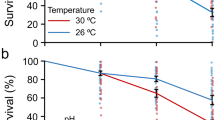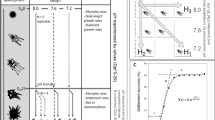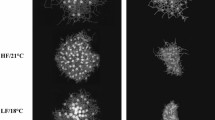Abstract
Larval stages are considered as the weakest link when a species is exposed to challenging environmental changes1,2. Reduced rates of growth and development in larval stages of calcifying invertebrates in response to ocean acidification might be caused by energetic limitations3. So far no information exists on how ocean acidification affects digestive processes in marine larval stages. Here we reveal alkaline (∼pH 9.5) conditions in the stomach of sea urchin larvae. Larvae exposed to decreased seawater pH suffer from a drop in gastric pH, which directly translates into decreased digestive efficiencies and triggers compensatory feeding. These results suggest that larval digestion represents a critical process in the context of ocean acidification, which has been overlooked so far.
This is a preview of subscription content, access via your institution
Access options
Subscribe to this journal
Receive 12 print issues and online access
$209.00 per year
only $17.42 per issue
Buy this article
- Purchase on Springer Link
- Instant access to full article PDF
Prices may be subject to local taxes which are calculated during checkout




Similar content being viewed by others
References
Kurihara, H. Effects of CO2-driven ocean acidification on the early developmental stages of invertebrates. Mar. Ecol. Prog. Ser. 373, 275–284 (2008).
Dupont, S., Ortega-Martinez, O. & Thorndyke, M. Impact of near-future ocean acidification on echinoderms. Ecotoxicology 19, 449–462 (2010).
Stumpp, M. et al. Acidified seawater impacts sea urchin larvae pH regulatory systems relevant for calcification. Proc. Natl Acad. Sci. USA 109, 18192–18197 (2012).
Stumpp, M., Trübenbach, K., Brennecke, D., Hu, M. Y. & Melzner, F. Resource allocation and extracellular acid-base status in the sea urchin Strongylocentrotus droebachiensis in response to CO2 induced seawater acidification. Aquat. Toxicol. 110–111, 194–207 (2012).
Stumpp, M., Wren, J., Melzner, F., Thorndyke, M. C. & Dupont, S. CO2 induced seawater acidification impacts sea urchin larval development I: Elevated metabolic rates decrease scope for growth and induce developmental delay. Comp. Biochem. Physiol. A 160, 320–330 (2011).
Piper, D. W. & Fenton, B. H. pH stability and activity curves of pepsin with special reference to their clinical importance. Gut 6, 506–508 (1965).
Sharma, B. R., Martin, M. M. & Shafer, J. A. Alkaline proteases from the gut fluids of detritus-feeding larvae of the crane fly, Tipula abdominalis (Say) (Diptera, Tipulidae). Insect Biochem. 14, 37–44 (1984).
Sachs, G. in Physiology of The Gastrointestinal Tract (ed. Johnson, L. R.) 1119–1138 (Raven, 1994).
Sivertsen, K. Geographic and environmental factors affecting the distribution of kelp beds and barren grounds and changes in biota associated with kelp reduction at sites along the Norwegian coast. Can. J. Fish Aquat. Sci. 54, 2872–2887 (1997).
Berenbaum, M. Adaptive significance of midgut pH in larval Lepidoptera. Am. Nat. 115, 138–146 (1980).
Felton, G. W. & Duffey, S. S. Reassessment of the role of gut alkalinity and detergency in insect herbivory. J. Chem. Ecol. 17, 1821–1836 (1991).
Stahmann, M. A. Plant proteins. Annu. Rev. Plant Physiol. 14, 137–158 (1963).
Schwenzfeier, A., Wierenga, P. A. & Gruppen, H. Isolation and characterization of soluble protein from the green microalgae Tetraselmis sp. Biores. Tech. 102, 9121–9127 (2011).
Manahan, D. T. Adaptation by invertebrate larvae for nutrient acquisition from seawater. Am. Zool. 30, 147–160 (1990).
Sterner, R. W. & Hessen, D. O. Algal nutrient limitation and the nutrition of aquatic herbivores. Annu. Rev. Ecol. Syst. 25, 1–29 (1994).
Hwang, P., Lee, T. H. & Lin, L. Y. Ion regulation in fish gills: recent progress in the cellular and molecular mechanisms. Am. J. Physiol. Integr. Comput. Physiol. 301, R28–R47 (2011).
Skou, J. C. & Esmann, M. The Na,K-ATPase. J. Bioenerg. Biomembr. 24, 249–261 (1992).
Manahan, D. T., Davis, J. P. & Stephens, G. C. Bacteria-free sea urchin larvae: Selective uptake of neutral amino acids from seawater. Science 220, 204–206 (1983).
Davis, J. P., Keenan, C. L. & Stephens, G. C. Na+-dependent amino acid transport in bacteria-free sea urchin larvae. J. Comput. Biochem. 156B, 121–127 (1985).
Leong, P. K. K. & Manahan, D. T. Metabolic importance of Na+/K+- ATPase activity during sea urchin development. J. Exp. Biol. 200, 2881–2892 (1997).
Stumpp, M., Dupont, S., Thorndyke, M. C. & Melzner, F. CO2 induced acidification impacts sea urchin larval development II: Gene expression patterns in pluteus larvae. Comp. Biochem. Physiol. A 160, 320–330 (2011).
Bond, J. S. & Butler, P. E. Intracellular proteases. Annu. Rev. Biochem. 56, 333–364 (1987).
Packard, B. Z. & Komoriya, A. Intracellular protease activation in apoptosis and cell-mediated cytotoxicity characterized by cell-permeable fluorogenic protease substrates. Cell Res. 18, 238–247 (2008).
Burke, D. R. Structure of the digestive tract of pluteus larva of Dendraster excentricus (Echinodermata: Echinoidea). Zoomorph 98, 209–225 (1981).
Pfohl, R. J. Alkaline phosphatase of sea urchin embryos: Chromatographic and electrophoretic characterization. Dev. Biol. 44, 333–345 (1975).
Meyer, E. & Mannahan, D. T. Nutrient uptake by marine invertebrates: cloning and functional analysis of amino acid transporter genes in developing sea urchins (Strongylocentrotus purpuratus). Biol. Bull. 217, 6–24 (2009).
Cruz-Rivera, E. & Hay, M. E. Can quantity replace quality? Food choice, compensatory feeding, and fitness of marine mesograzers. Ecology 81, 201–219 (2000).
Slansky, F. Jr & Wheeler, G. S. Caterpillars’ compensatory feeding response to diluted nutrients leads to toxic allelochemical dose. Entomol. Exp. Appl. 65, 171–186 (1992).
Strathmann, R. R., Fenaux, L. & Strathmann, M. F. Heterochronic developmental plasticity in larval sea urchins and its implications for evolution of nonfeeding larvae. Evolution 46, 972–986 (1992).
Ellis, D. A. A new universal buffer system. Nature 191, 1099–1100 (1961).
Acknowledgements
The authors are grateful to N. Dorey and E. Butera for their help with the larval culture. M.H. has received financial support from the European Community’s Seventh Framework Programme FP7/2007–2013 under grant agreement no 265847 and an Alexander von Humboldt fellowship. M.S. was financially supported by the Royal Swedish Academy of Sciences (Kungliga Vetenskapsakademien). F.M. and M.B. were supported by the Excellence Cluster Future Ocean and the German Ocean Acidification programme BIOACID. I.C. and S.D. were financially supported by the Linnaeus Centre for Marine Evolutionary Biology at the University of Gothenburg (http://www.cemeb.science.gu.se/) and supported by a Linnaeus grant from the Swedish Research Councils VR and Formas.
Author information
Authors and Affiliations
Contributions
M.S., M.H. and S.D. designed the study, conducted experiments, analysed the data and compiled the manuscript with the help of all other co-authors. R.S. contributed to enzyme characterizations. I.C. collected samples and performed the culture experiments including seawater chemistry analyses. M.B. and F.M. supported the planning operations for micro-electrode measurements and larval cultures.
Corresponding author
Ethics declarations
Competing interests
The authors declare no competing financial interests.
Supplementary information
Rights and permissions
About this article
Cite this article
Stumpp, M., Hu, M., Casties, I. et al. Digestion in sea urchin larvae impaired under ocean acidification. Nature Clim Change 3, 1044–1049 (2013). https://doi.org/10.1038/nclimate2028
Received:
Accepted:
Published:
Issue Date:
DOI: https://doi.org/10.1038/nclimate2028
This article is cited by
-
Variable food alters responses of larval crown-of-thorns starfish to ocean warming but not acidification
Communications Biology (2023)
-
Direct and latent effects of ocean acidification on the transition of a sea urchin from planktonic larva to benthic juvenile
Scientific Reports (2022)
-
Upper environmental pCO2 drives sensitivity to ocean acidification in marine invertebrates
Nature Climate Change (2022)
-
Development of larviculture protocols for the long-spined sea urchin (Diadema antillarum) and enhanced performance with diets containing the cryptophyte Rhodomonas lens
Aquaculture International (2022)
-
Near-future oceanic CO2 delays development and growth in early-stage larvae of the endemic New Zealand sea urchin, Evechinus chloroticus
Marine Biology (2021)



